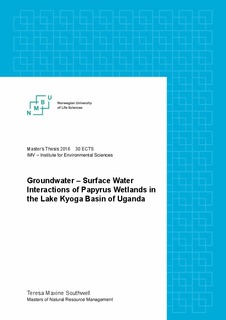| dc.contributor.advisor | French, Helen | |
| dc.contributor.author | Southwell, Teresa | |
| dc.coverage.spatial | Uganda | nb_NO |
| dc.date.accessioned | 2016-08-11T11:32:29Z | |
| dc.date.available | 2016-08-11T11:32:29Z | |
| dc.date.issued | 2016-08-11 | |
| dc.identifier.uri | http://hdl.handle.net/11250/2398808 | |
| dc.description.abstract | Natural resources play an important role to the livelihoods of rural communities. Dependency on resources as a source of food and water means that poor usage and management of these resources can potentially impact many lives. Understanding of system processes of natural resources can aid in development of management plans and education of stakeholders. The purpose of the study was to simulate the dynamic relationship of groundwater and surface waters of the study area and investigate how the natural system behaved under seasonal changes. Modelling program Modelmuse, developed by the United States Geological Survey (USGS), was used for developing a simulation of a section of the Naigombwa wetland, located in the Kyoga basin of Uganda.
Collected field data from January 2016 was used to assist in the creation of the model, as was previous data, which was collected as part of an associated project.
Precipitation data collected from an established weather station showed that the region experienced four seasons per year, two rainy seasons and two dry seasons. Soil analysis was conducted on the study area by collecting samples from 4 zones on each side of the wetland. Textural analysis on collected soil samples showed high percentages of clay throughout the study area.
Simulation of the study area using Modelmuse found that groundwater was the dominating process within the hydrogeological processes of the study area. Sensitivity analysis on models showed that groundwater levels were more sensitive to changes of hydraulic conductivity than precipitation. Although Calibration of the model was conducted by assigning observation wells groundwater and wetland regions of the model.
A simulation period of a year was chosen so that changes to the system as a response to seasonality changes could be simulated. Creation of the simulation model required substantial correlation from other data, as collected data was not enough to cover a simulation period of an entire year. Because of missing data many of the results obtained from the studies results are accompanied with a higher margin of error.
Numerical modelling of hydrogeological processes is a important tool for understanding system processes and also simulating changes to systems from anthropogenic influences. Development of accurate models can be complicated and require large amounts of data. It is hoped that the findings of this thesis can aid in further studies conducted within the region. | nb_NO |
| dc.language.iso | eng | nb_NO |
| dc.publisher | Norwegian University of Life Sciences, Ås | |
| dc.rights | Navngivelse 3.0 Norge | * |
| dc.rights.uri | http://creativecommons.org/licenses/by/3.0/no/ | * |
| dc.subject | hydrogeology | nb_NO |
| dc.subject | wetlands | nb_NO |
| dc.subject | modelmuse | nb_NO |
| dc.subject | groundwater | nb_NO |
| dc.title | Groundwater – surface water interactions of papyrus wetlands in the Lake Kyoga basin of Uganda | nb_NO |
| dc.type | Master thesis | nb_NO |
| dc.subject.nsi | VDP::Mathematics and natural science: 400 | nb_NO |
| dc.source.pagenumber | 96 | nb_NO |
| dc.description.localcode | M-MINA | nb_NO |

